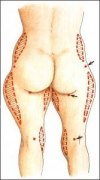Liposuction
This is an operation to remove unwanted fat deposits from specific area of the body and therefore keep the shape of your body.

Suction-assisted lipectomy - liposuction - is a surgery during which the subcuticular fatty tissue is reduced with a tube and vacuum device at places where excessive fat deposits occur. However, liposuction is not a method that cures obesity. Also, liposuction is not a solution to decreasing the fat deposits on large areas or in the locations where the fatty tissue layer is comparatively thin (thigh front, calves, back) because uneven bumpy patches may occur on the skin that are difficult to remove. Quality, contractility and elasticity of the skin is vital for the resulting effect and with elasticity and contractility being insufficient -and getting poorer with age or a conspicuous weight loss - the skin after surgery may remain faded and slackened (abdomen, inner side of thighs).
The first, very important step to be taken before any decision to have surgery is a personal consultation with an experienced plastic surgeon. A state of good health is a natural prerequisite. It is not possible to determine precisely how much fat' should be removed during the surgery because the elasticity of the skin must be monitored after the liposuction is performed. .With asymmetry, it is also impossible to determine in advance that the quantity of removed fatty tissue will be such to provide for strict symmetry. It should be noted that the total amount of the fat removed at a time should not be in excess of 1,500 -2,500 millilitres (depending on the total weight) to avoid any complications of the general state of health. Where the liposuction is more extensive, the surgery should be done repeatedly at stages at an interval of 3 -6 months. The optimum patient's age bracket is 18 -35 years. In an older age, liposuction may be done with a very good result in terms of reducing the fatty tissue volume but the risk of slackened skin and small subcutaneous uneven patches increases. Suitable for being treated with liposuction are particularly areas of hips, thighs in the area of the ilium and the inner part of the knees.

Surgery and Postoperative Period
The surgery is performed under general anaesthesia. Incisions are 4 -6 mm long and conducted in the least visible locations. Immediately after the surgery, plastic roll-ons are applied; lost fluids are replenished by intravenous infusions. More or less extensive bruising, soreness and temporary loss of tenderness in the affected locations are common in the postoperative period.
Resting is recommended for 3 -4 days following surgery; any walking should be restricted to inevitable needs (toilet, eating). Later on, mild and gradual load is possible. Suture is removed on the 7th ?l0th day after the surgery. If the rest regimen is maintained, swelling of legs and fever may occur. If subjective complaints (more pronounced pain) or complications (conspicuous swelling, fever above 380 Celsius) arise, the patient is required to report as quickly as possible at the department or to have consultation with the doctor on the phone. Unrestricted physical activities (exercise, sports) may be resumed 3 -4 weeks after surgery. During the first month after surgery, the roll-on should be taken off only for the time required for personal care. Several times a day, massages of the affected locations should be performed with a roller. The state is checked 4 weeks after the operation but the roll-on should be worn for another 1 -2 months, particularly during the day, while active and under strain. Three months after the surgery, the patient will report for his/her last check-up. After this period it is possible to assess the rate of success of the surgery. The effect is then permanent. The data presented is based on a common post-operation course. However, a recovery is an individual process depending not only on healing abilities of any individual body, but also on every patient's conscientiousness. The patient is expected to set such conditions for a period of several days after his operation to be able, in case of any subjective problems or complication, to come as soon as possible for examination to our department. A positive operation result and mutual satisfaction is in your interest as well as in ours. Mutual trust and co-operation of the patient with the surgeon is a vital precondition.








